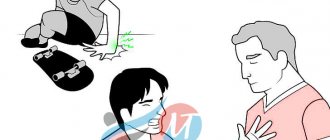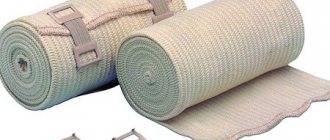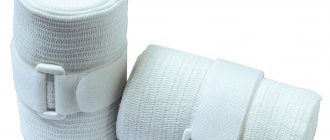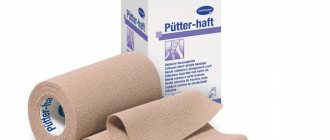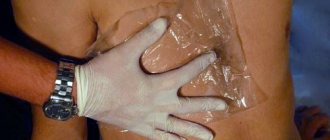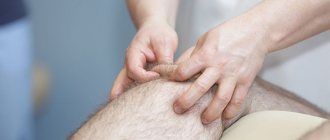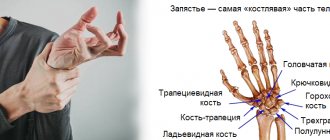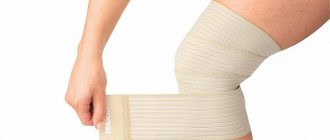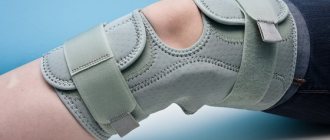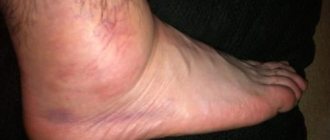The most active joint in the human body is the knee; it experiences large static and dynamic loads, and therefore is often subject to injuries and diseases. In these cases, elastic bandaging of the knee is a good help. It is used for bruises, dislocations, sprains, it is necessary in the treatment of inflammation in the joint, for fixing a sterile bandage on a wound.
Tight bandaging of the knee allows you to create peace for it, limit movement, as a result, pain and swelling of the tissues are reduced, and recovery time is reduced. It is widely used in strength sports to prevent damage to the ligaments and meniscus of the knee joint. The bandage is effective provided that it is correctly selected and applied correctly, which can be mastered by anyone without a medical education.
Types of elastic bandages
There are 3 types of elastic bandages depending on their degree of extensibility:
- low elasticity, when stretching is possible only 1.5 times (up to 50-60% of the length);
- medium elasticity, when it can be maximally stretched to 70-130% of its length;
- high elasticity, stretching 2-3 times its length (200-300%).
The degree of elasticity is indicated on its packaging, and its choice must be agreed with your doctor.
A weakly stretchable bandage will not provide reliable immobilization of the joint, so it is suitable for dressing the wound - fixing it with a sterile napkin. For the same purpose, you can use bandages of medium elasticity, including bandaging the knee after surgery, in case of inflammation. But high elasticity is perfect for injuries or for sports, when you need to tightly bandage a joint.
Pharmacies offer a large selection of elastic bandages, the price for domestic products varies from 50-170 rubles, for foreign ones - from 250 to 400 rubles. However, the main criterion when choosing is the size (length, width) and the degree of elasticity, regardless of cost.
What is an elastic bandage?
An elastic bandage is a material whose structure includes specially woven polyurethane or natural elastic fibers. It is thanks to its elasticity that this bandage gives a head start to a regular medical bandage. It's all about the following features:
- does not deform;
- repeats the anatomical features of the body;
- does not slip or stretch;
- can be used repeatedly;
- good fixation;
But, despite its many advantages, before buying an elastic medical bandage, it is still necessary to take into account that it is not always suitable for bandaging any injuries, and if it is applied incorrectly, the blood circulation process can be disrupted.
Overlay Types
Before bandaging the knee, you need to lay or sit the patient so that the leg is in a horizontal position, relaxed and slightly bent at the knee joint. Further, depending on the purpose, several methods of bandaging are used:
- circular;
- spiral;
- "turtle".
Circular bandage
The simplest type of bandaging, in which the end of the bandage is fixed above the knee with one hand, and with the other, stretching it, they make several rounds around the joint. The end cannot be tied; it is secured with adhesive tape, a pin or the fastener included in the kit. This bandage is not very strong and can roll off when moving, especially in a child due to high mobility.
Spiral bandage
The peculiarities of a spiral or creeping bandage are that each subsequent revolution moves up or down by 1/3-½ the width of the previous one. In the first case, an ascending bandage is applied: the end of the bandage is fixed with the hand under the joint, and turns are made with the other hand, moving them upward. When applying downwards, the bandage is held with the hand above the joint, and the tours are applied with the other hand, moving downwards. This type of bandage is more reliable than a circular one, however, the rounds can move up or down with movement.
"Turtle" bandage
This type of bandaging is the most reliable for the knee; it covers a large area and holds well without slipping. The essence of the bandage is the sequential crossing of rounds in the area of the popliteal fossa with a transition from bottom to top, or from top to bottom. Depending on this, the overlay can be of 2 types:
- Criteria for choosing an elastic bandage for the knee, methods for wrapping it
A converging bandage is applied starting from the periphery to the center. The first round of the bandage is fixed 20 cm below the knee, behind it they go obliquely upward and make a round 20 cm above the knee. Afterwards, they again make a cross behind the knee and move the bandage down, make a tour higher by 1/3-½ of the width of the bandage, make a cross and go up. Similarly, each tour is shifted down from above. The bandaging ends at the level of the middle of the joint. This bandage with rolling crosses prevents the bandage from moving up and down.
A divergent bandage is applied starting from the middle of the joint, with each subsequent round of the bandage moving up and down with a cross at the back. The last round is wrapped around the shin 20 cm below the joint and fixed.
Sprain bandage
Any sprain of the knee joint must be immobilized. To do this, you can bandage it in any of the following ways, depending on the severity of the injury. For mild cases, circular bandaging is sufficient; for severe injuries with severe swelling, it will be correct to bandage in a more reliable “turtle” way. In any case, the choice of the type of bandage is made by the traumatologist after examining the patient.
The question of how long you need to wear a bandage on your knee is decided individually.
For a mild injury, 1 week is enough, and for severe sprains and ligament ruptures, the bandage is worn for up to 1 month or longer.
Very important points that should not be forgotten:
- the bandage should not overtighten the limb, as evidenced by pain, swelling and numbness of the leg below the knee;
- The bandage must be removed at night to restore blood circulation;
- do not tie the bandage in a knot, but use a special fastener or pin;
- under the bandage there may be fogging and irritation of the skin; after removing it, be sure to wash the skin with soap and water or treat it with an antiseptic (alcohol, furatsilin solution, chlorhexidine);
- do not use an old stretched bandage, it does not fulfill its function;
- You should wash or change the bandage as it gets dirty, but at least 2 times a week.
In what cases should this remedy be used?
Dressing material is used in different situations. Typically, this material is a preventive measure for knee injury or impairment. However, there are other cases where elastic bandages are used. Of course, the decision about the need to apply a bandage is made by the doctor. This remedy is prescribed in the following cases:
- orthopedic diseases;
- swelling;
- sports injuries;
- thrombophlebitis;
- bruises and dislocations.
The doctor recommends applying bandages not only for injuries, but also for various diseases (arthrosis, arthritis, synovitis). They can be inflammatory and non-inflammatory. Bandages help relieve or reduce pain and reduce stress on the knees.
Kinds
Who is recommended to use an elastic bandage (indications for bandaging the knee joints) depend on the type of dressing material chosen.
- A bandage with low elasticity stretches by sixty percent of its length. It is used for varicose veins, lymphedema (lymphostasis), venous insufficiency and post-thrombotic disease.
- A bandage with an average degree of elasticity stretches by seventy to one hundred and thirty percent of its length. It is used after surgical treatment of blood vessels of the lower extremities. This dressing material is also used if there is a risk of developing venous pathology.
- A bandage with a high degree of elasticity is used to fix knee joints after injuries and under high loads on them to avoid damage. It is prescribed by traumatologists and rehabilitation specialists who treat diseases of the knee joints. Material with a lesser degree of elasticity is used very rarely in these cases.
Types of elastic bandages
All bandages are different in length and width, as well as in the degree of stretch. They are divided into several groups according to the degree of extensibility and in accordance with the purposes for which they can be used. There are three types of bandages:
- with low elongation - thirty to one hundred percent;
- with average elongation - one hundred to one hundred and fifty percent;
- with high elongation - from more than one hundred and fifty percent.
Bandages with 30-100% stretchability are used for various problems with veins. In addition, such knee bandages are used if you need urgent assistance, immediately apply a bandage and firmly fix the joint. This bandage helps reduce discomfort and pain for a while. However, in the future it is necessary to use other treatment methods.
Knee wraps with 100-150% stretchability are also used to treat vein diseases. Elastic knee wraps are also useful for supporting the joint and tissues after the cast is removed. They are also used for compression sclerotherapy. You can also use bandages with moderate stretch for knee injuries (if you need immediate help and relief). Such knee bandages help with arthrosis, as they reduce the load on the knee.
As for bandages with the highest elongation, they are used for severe varicose veins. Regarding knee problems, these high-stretch bandages are useful for post-surgery patients when swelling occurs.
Nuance! It is best to have a product with one hundred percent stretchability in your first aid kit. This is a universal size.
How to tie an elastic bandage
Elastic bandages are relatively new, preceded by a long history of woven bandages, thin or thick, in the form of a diaper or a long narrow strip, followed by knitted bandages, which created a more comfortable feeling for patients and made it possible to regulate the pressure of the bandage on the sore area. All this is done by the science of desmurgy - the art of applying bandages.
Elastic bandages are a rather complex product created for repeated use. Using various technologies, an elastic thread, such as latex, is wrapped in a single or double layer of cotton or synthetic thread. And from these “threads” the bandage itself is woven.
However, before you buy or wrap an elastic bandage, carefully study its packaging: elastic bandages, in addition to length and width, have different degrees of elongation - low, medium and high. These elastic bandages are used in various situations:
Low-extensibility bandages (extensibility of at least 30%) are used to treat complicated forms of chronic venous insufficiency and deep vein thrombosis; provide quick application of bandages when providing first aid; provide convenient and reliable fixation of dressings on affected areas of the body.
Medium extensibility bandages (extensibility of at least 100%) are used for the treatment of varicose veins, diseases with trophic complications, and for the treatment of postphlebitis syndromes. Recommended for maintaining soft tissues after plaster removal and compression sclerotherapy.
Highly tensile bandages (extensibility of at least 150%) are used for the treatment of varicose veins of I and II degrees, for the treatment of lipodermic diseases; used in the postoperative period for lymphedema, to maintain joints at rest after injuries and operations; recommended for bandaging bedridden patients.
The question: “how to wrap an elastic bandage” can be answered very simply - just like a regular bandage. Those. dressing with an elastic bandage should follow the schemes developed for dressing with a regular bandage.
Of course, there is a difference, it consists in the huge advantage of an elastic bandage - by creating additional continuous pressure (compression) perpendicular to its surface, it leaves soft tissues and joints the opportunity to move and function within certain limits.
This quality of the elastic bandage allows it to be used both for securing bandages and for treating injuries to the musculoskeletal system and diseases of the vascular and lymphatic systems.
How to properly wrap an elastic bandage
Before using an elastic bandage, let's consider the basic dressing schemes and the goals they serve.
Circular bandage.
We hold the edge of the bandage with our left hand, and with our right hand we make several rounds at the same level - as a rule, this is how they begin to apply an elastic bandage.
Spiral bandage - ascending and descending.
With an upward spiral, an elastic bandage is applied from bottom to top.
With a downward spiral, you need to apply an elastic bandage from top to bottom:
This is how they bandage the lower leg, hand or chest. Each subsequent round overlaps the previous one by about 1/3
Creeping bandage
Very often we have to solve the following problem: how to tie an elastic bandage around the entire leg or chest. In general, around a large surface.
To do this, you need to apply the bandage in two layers. In the first, we use a method similar to a spiral, but we do not overlap the previous round, but move away from it at a certain distance equal to the width of the bandage. And in the opposite direction we bandage or spiral, or some other method recommended by the doctor.
The creeping bandage is perfect for the arms (shoulder and forearm) and for the conical areas of the leg - thighs and lower legs. More complex techniques are used for bandaging joints: knee and ankle.
How to apply an elastic bandage to the ankle The most common is a cross-shaped (eight-shaped) bandage on the ankle joint.
The illustrations below show how to correctly apply an elastic bandage to the ankle joint:
Such a bandage will be appropriate for almost all injuries of the ankle joint.
How to apply it?
1) We make several turns of the bandage around the shin itself (secure it)
2) Move along the outside of the ankle under the instep
3) Wrap it around the ankle and bring it out again
4) Fasten around the shin
With such a bandage, the ankle joint retains mobility, and this is very important for maintaining the ability of an injured person to work. This type of bandage does not slip or create painful excessive pressure on any part of the foot or lower leg. If necessary, you can easily bandage a hard insole under the sole with such a bandage.
You can apply an elastic bandage to the ankle either over the sock or under the sock. It all depends on the nature and extent of damage to the ankle joint.
A cross-shaped bandage is also applied to the chest and neck:
Now let's discuss how to properly bandage your knee with an elastic bandage. By the way, we will also bandage the elbow!
Turtle headband.
Bandaging the knee and elbow joint with an elastic bandage is the most common procedure in everyday life.
Take a close look at the picture below, this is the so-called “Turtle” bandage for the knee joint:
Left and center - we wrap an elastic bandage towards the center, this is a “converging” tortoiseshell bandage.
But on the right we wrap an elastic bandage in “up and down” circles from the center - this is a diverging turtle bandage.
The purpose of such a bandage is to limit the mobility of the knee joint and NOT FALL OFF.
So how do you put an elastic bandage on your knee so that it doesn't fall off?
How to wrap your knee with an elastic bandage
The first thing you should do is ask the patient to bend their knee so that it is as comfortable as possible.
The knee can also be a sprain!
The bandage will need to be wound as evenly as possible to avoid wrinkles.
We place the bandage on top of the knee and fix it with a double turn. We lower it below the knee and fix it again. The intersection is under the knee. The procedure is repeated in reverse order and so on several times.
You can use an elastic bandage on the elbow joint in the same way.
How to properly bandage your foot with an elastic bandage in the heel area
Believe me, it's difficult!
The heel is rounded and the bandage tends to slip off when walking up or down.
The most successful bandage is in the form of a divergent tortoiseshell bandage, but the first securing move is made directly through the heel:
For heel bursitis, a more voluminous bandage is needed:
This bandage makes it possible to apply medications and lotions to the heel, and also protects the heel quite well from stress.
How to wrap your leg with an elastic bandage for sprains
Before bandaging a sprained leg, you need to cool it down - to do this, you will have to lie down for half an hour with a cold heating pad, an ice bag, or just a bottle of cold water.
It is strictly forbidden to overheat the sprained area or lubricate it with warming ointments.
The next task is to immobilize the stretched area as much as possible. Bed rest may be prescribed for several days.
When spraining a ligament, you need to bandage the limb from BOTTOM. This will prevent tissue swelling that is inevitable during stretching).
An elastic bandage is attached below the stretched area (let's say these are the toes).
Here, the screw bandaging technique is most suitable, which in the joint area may contain elements of a tortoiseshell bandage.
Even after applying a bandage, apply an ice pack to the sprained area.
It is good to alternate such applications every 15 minutes.
At night, you can loosen the bandage a little.
Modern desmurgy offers a technique for taping sprained ligaments:
Kinesio tape or elastic tape bandage of low extensibility, adhesive - it is glued in the directions of damaged ligaments or muscles, it is also called an elastic bandage.
This elastic bandage is literally indispensable during the rehabilitation period after an injury.
If the ligaments or muscles are injured and are unable to stretch, this method of application is used - the kinesio tape is stretched before applying it to the skin. Due to its elasticity, the tape contracts and forms folds on the skin and at the same time supports the injured area.
How to bandage a knee?
How does the procedure itself work? How to bandage a knee? There are instructions that will help bandage the damaged area:
- The leg should not be tense.
- The roll should be held in one hand and the free edge in the other.
- The loose end must be placed behind the knee, below the cup.
- Bandage the leg along the fold under the joint, slightly covering the free end.
- All layers slightly cover the previous ones.
- Each time you need to slightly stretch the layer, but not too much.
- Then fix the end of the bandage, do this by tucking it under any layer.
The procedure must be carried out first with the lower part, and then wrap the upper part of the knee in the same way. It is important that the bandage does not interfere or put pressure. To do this, bend your leg several times. Properly wrapping your knee with an elastic bandage is not very difficult. Of course, you won’t be able to do it quickly right away, but after some practice, applying an elastic bandage will be much easier.
Here are some tips on bandage technique:
- The bandage must be wound correctly and evenly, as microtrauma may occur.
- The bandage should be opened outward so that it does not stretch prematurely.
- Each level of dressing should overlap the next by no more than 50%.
- You need to bandage a slightly larger area than the injury itself - 10 cm.
- At the end of bandaging, it is necessary to slightly loosen the tightness.
Bandaging
It is necessary to use a bandage to fix an injured joint after surgery or before a heavy workout.
The bandage is worn to fix the joint, dose loads on it and speed up the recovery process. It is also used to distribute loads when performing therapeutic exercises for the gradual development of joint structures.
If you have suffered a knee injury and a specialist has prescribed the use of an elastic bandage, then you need to know how to bandage the knee joint with an elastic bandage so that the bandage does not put pressure and has a healing effect.
Preparation
Before applying a bandage to your knee, you need to purchase a bandage with the elastic characteristics you need. The dressing may be called a compression bandage, pressure bandage or elastic bandage. Before purchasing it, ask your pharmacist about its distensibility characteristics.
To ensure that the elastic bandage wrapped around the knee is well secured, it comes with special fasteners or there are Velcro on the edges of the material. If there are no fasteners, you can use a regular pin.
Elastic bandage
Leg position
The bandaging technique will only be correct if the patient's lower limb is placed in the correct position. In order to bandage your leg, you need to stretch it forward without straining. The knee joint should be in a slightly bent position, but at the same time be in a relaxed state.
Bandaging technique
The most effective bandage technique is the so-called turtle bandage. It involves winding the bandage in a converging and diverging position. You can see a detailed diagram of winding the bandage in the figure.
Turtle bandage: (Convergent - left and center, Divergent - right)
Convergent bandaging involves applying the first two turns below the joint, and the next two above the knee. Next, it is necessary to apply turns so that the upper sections alternate with the lower ones, connecting in the middle of the damaged knee. This is where the bandage will be fixed.
Divergent bandaging should begin from the middle of the knee joint, winding turns above and below the joint, alternating directions.
Bandaging rules
Regardless of which bandage technique you choose, you need to apply the bandage in such a way that:
- The bandage moved back from the injured area by at least twenty centimeters.
- Subsequent turns should overlap the previous ones by seventy percent.
- Along the edges of the joint, the bandage should be looser, and towards the middle of the knee, it should be tightened more tightly.
The bandage on the knee joint should be applied so that it does not put pressure and does not disrupt the blood flow in the limb. Wearing a bandage should not lead to discomfort or pain. If pain occurs, you need to loosen the elastic material.
The bandage should not interfere with the motor activity of the knee joint, but it should also not allow it to slip. If the bandage is loosely wound, it must be tightened by increasing the tension.
The bandage should fit snugly to the joint structure, without over-tightening or causing disruption of blood flow. If you can’t get your finger under the bandage, it needs to be loosened. Also, loosening should be done if the skin begins to change color, go numb and tingle.
To properly apply a bandage to the knee joint, you must follow the following rules:
- A stretched bandage cannot be used.
- Periodically, the lower limb should rest from the bandage. If the bandage is applied to prevent damage to the knee during physical activity, then the elastic bandage is removed at rest.
If everything is done correctly, then bandaging will only bring benefits and will allow the joints to recover faster or avoid injury during heavy physical activity.
Contraindications to applying a bandage
Is it always possible to do dressings? No, there are cases when applying a bandage is prohibited. The final decision on the possibility or impossibility of such a procedure is made by the doctor. But in the following cases you definitely can’t bandage:
- diabetes;
- obliteration of arteries, atherosclerosis;
- infection at the site of application;
- inflammation in the area where the bandage is applied.
Read about how to apply a compress here.
In addition, some side effects may occur during use. For example, in summer it is very hot in such headbands. Consequently, skin problems may arise. It is possible to be allergic to substances contained in the bandage. And the bandage exerts excessive pressure not only on the joint, but also on the surrounding tissues, which can also lead to negative consequences.
Such bandages are a fairly effective means of relieving knee pain and reducing stress. However, you should not get carried away with this method of treatment, and even more so, you should not use an elastic bandage as the main treatment. An integrated approach to the treatment of a disease or injury will lead to a quick cure and reduce the risk of complications.
What is arthrosis of the knee joint?
Osteoarthritis of the knee joint is a chronic disease that results in changes in the shape of the knee joint and pain when walking and playing sports. The knee joint is most vulnerable to arthrosis. This is due to the fact that the knee bears the weight of the entire body and bears the load when walking.
Mechanical impact destroys the menisci - cartilaginous “linings” between the bones of the pelvis and lower legs, shock-absorbing the joint and providing it with mobility. The menisci flatten and become thinner. The joint changes shape, the nutrition of the cartilage is disrupted, and the cartilage cells begin to die.
How does a compression bandage help with knee arthrosis?
By fixing the knee joint, the Intex compression bandage reduces the load on the ligaments and muscles that ensure the movement of the leg in the knee. As a result, the load on the joint is eased, the destruction of the menisci is slowed down and pain is reduced.
The elastic bandage stimulates the work of the blood vessels surrounding the joint, improving the supply of oxygen and nutrients to the cartilage. At the same time, the compression bandage ensures the delivery of chondroprotectors - drugs that restore and protect the menisci.
Effect
Bandaging the knee joints allows you to speed up the recovery process and is also an excellent preventative measure for those who play sports.
The muscles under the bandage are toned all the time, which means that blood flow in the vascular network increases.
If the bandage is applied only to the knee joint structures, then fixation occurs only in the intra-articular elements, which allows them to maintain their correct position during loads on the joint.
Elastic compression material allows you to:
- Prevent sports injuries.
- Protect the venous network from stretching.
- Keep all elements of the joint in the correct position.
- Normalize blood flow and metabolic processes in tissues.
- Prevent the formation of blood clots.
In order for the application of an elastic bandage on the knee to give the desired result and not lead to complications, it must be correctly fixed on the joint, then no problems will arise. If you are unable to fix your knee on your own, seek help from a doctor.
How to properly apply a compression bandage for knee arthrosis?
To fix the knee with arthrosis, use a low-tensile bandage (stretches by 50% of the length at rest) 1.5-2 m long and 8-10 cm wide. 1. Apply the bandage in the morning, when swelling and inflammation are minimal. 2. Secure the bandage with 1-2 turns 20 cm below the knee. Apply the bandage so that the new wrap overlaps the previous one by 2/3 of the width. 3. Pass the bandage obliquely through the popliteal fossa, place it on the thigh, twenty centimeters above the joint. Secure the bandage with 1-2 turns. 4. Pass the bandage from top to bottom so that the new wrap of the bandage crosses the previous one obliquely. A cross of bandage strips should form in the popliteal area. Secure the bandage with 1-2 turns under the knee. 5. When you have completely bandaged your knee, secure the bandage with a turn of the bandage through the middle of the knee. Secure the bandage using the clip that is included with the Intex bandage.
Published in the Bandages sectionReferences:
- https://travmoved.com/preparat/elastichnyj-bint-na-koleno/
- https://prokoleni.ru/med/elastichnyiy-bint-na-koleno
- https://bint.ru/blog/artroz-kolennogo-sustava-i-elastichnyj-bint/
